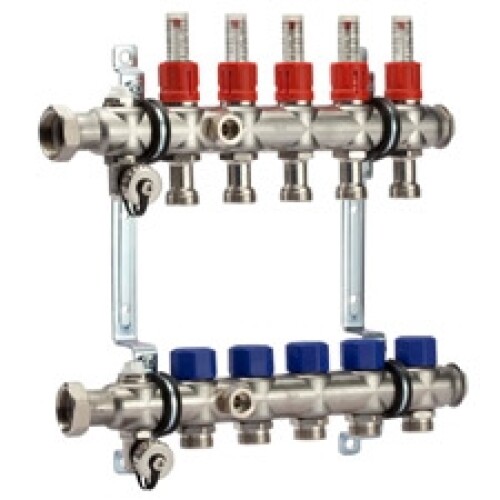Collectors
Manifolds: Optimal Management and Distribution in Hydronic Systems
Manifolds are essential components in hydronic systems, used to distribute and balance fluids, such as water or refrigerants, across various circuits within an installation. These devices, employed in heating, cooling, and water supply applications, ensure uniform and efficient fluid distribution, enhancing the overall performance of the system.
Thanks to their versatility, manifolds are widely used in various settings, from underfloor heating systems to large industrial plants.
Types of Manifolds
There are different types of manifolds, each designed to meet specific application needs and operational conditions. The main categories include:
- Underfloor Heating Manifolds: These manifolds distribute hot water to the circuits of underfloor heating systems, ensuring even heat distribution. They are often equipped with control valves and flow meters to balance the flow in each circuit, ensuring that all areas receive an adequate amount of heat.
- Radiant Heating and Cooling Manifolds: Used for both heating and cooling, these manifolds regulate the fluid supplying radiant panels installed in walls, floors, or ceilings. These systems provide high thermal comfort and optimal energy efficiency due to the uniform temperature distribution.
- Plumbing Manifolds: In domestic water systems, manifolds distribute cold and hot water to various usage points, such as faucets, showers, and sinks. These manifolds improve water management and reduce pressure losses, ensuring a constant and steady supply.
- Solar Thermal Manifolds: In solar thermal systems, these manifolds distribute the heat-transfer fluid heated by solar panels to storage and usage circuits. They must be made from materials resistant to high temperatures and corrosion, ensuring long durability and high efficiency.
- Industrial Manifolds: In industrial environments, manifolds manage large volumes of fluids in processes requiring precision and reliability. They are designed to handle high-pressure or high-temperature fluids or withstand particularly demanding operating conditions.
Applications of Manifolds
Manifolds are used across a wide range of sectors, each requiring specific technical characteristics to meet operational demands.
- Residential Applications: Manifolds are crucial for underfloor heating systems, offering superior thermal comfort through even heat distribution. These systems are particularly valued in new constructions and home renovations, where energy efficiency is a priority.
- Commercial Applications: Manifolds are used in centralized heating and cooling systems, managing fluid distribution to different zones of a building, such as offices, conference rooms, and common areas. In this context, manifolds with automatic flow control can optimize energy use, reducing operational costs and improving occupant comfort.
- Industrial Applications: In industrial processes, precise control of fluid flow and temperature is essential. For example, in the chemical and pharmaceutical industries, manifolds regulate fluid transfer between different production stages, ensuring product quality and operational safety.
- Renewable Energy Systems: In solar thermal systems, manifolds play a crucial role in distributing heat collected from solar panels. These systems require highly efficient and durable manifolds capable of managing high temperatures and varying operating conditions.
By selecting the appropriate manifold type and configuration, businesses and homeowners can achieve greater energy efficiency, better performance, and long-term system reliability.






